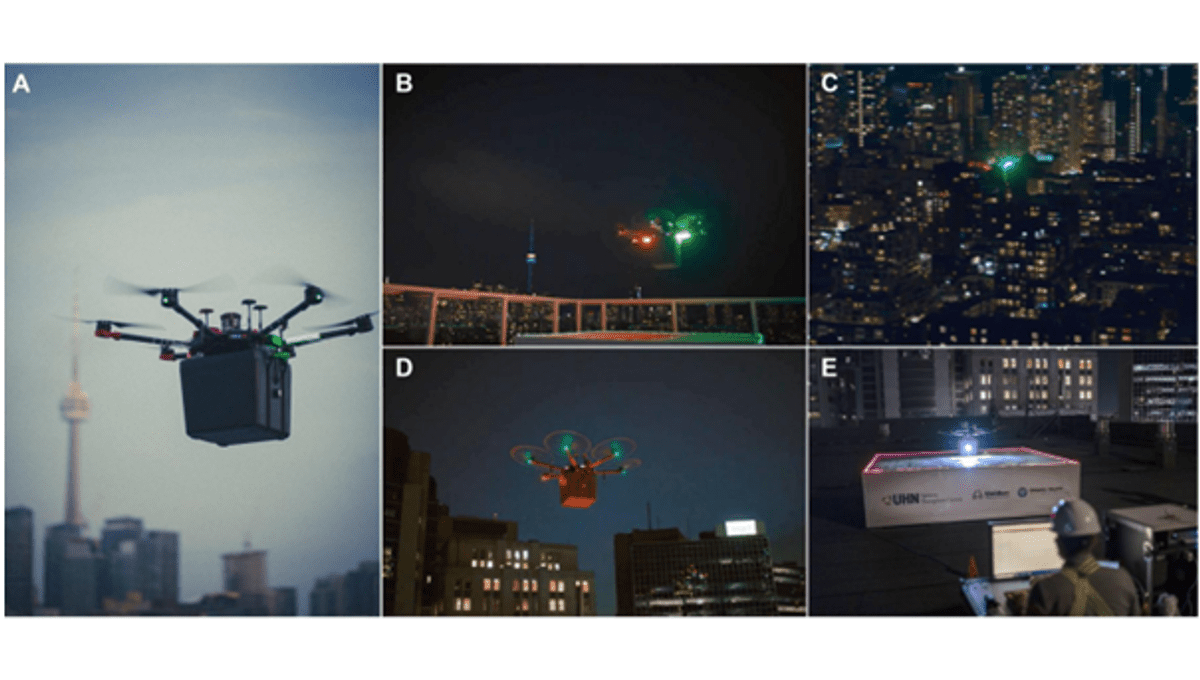
A modified drone carried a donor lung from Toronto Western Hospital to Toronto General Hospital in the space of five minutes, with the organ successfully transplanted into a patient with pulmonary fibrosis. Although donor organs have been transported between hospitals by drone before, lungs and hearts are considered particularly challenging. The operation demonstrates drones are a practical method for moving any organ that can be transplanted to the hospital with the most suitable recipient.
Hundreds of people worldwide are on waiting lists for donor organs, and many will die before they can receive what they need. A shortage of donors is only part of the problem – many organs go to waste because they can’t be delivered to a compatible recipient in time.
Traffic is one of the many obstacles to getting every healthy organ to a person who will benefit from it. Even with flashing lights and wailing sirens, ambulances can lose precious time getting between hospitals in a major city. This may soon be a thing of the past, however, after the description in Science Robotics of a life-saving drone flight performed last year.
The first reported drone transfer of a donor organ was a kidney, allowing a 44-year-old recipient to cease eight years of dialysis. Any organ has a better chance of successful implantation if it’s delivered quickly, but kidneys can last as long as 48 hours outside the body. Saving a few minutes in transit is helpful, but rarely essential. Delivery between cities is a bigger challenge, but still often possible.
However, hearts and lungs need to be transplanted within 4-6 hours of the donor’s death. Allowing for the time to perform the operation at each end, there is precious little left for delivery if the donor does not die in the same hospital as a priority recipient.
A team at the University Health Network, Toronto, had been planning to deliver a lung by remote control for years, installing a specially designed lung transport box in an M600 Pro Drone. They also removed the landing gear and normal payload rack to increase the weight available – lungs may not be heavy, but all the equipment required to keep them functioning is a different matter. Despite the addition of a parachute recovery system, cameras, lights, and GPS trackers, the entire system weighs less than 25 kilograms (55 pounds).
Over 400 test flights were undertaken between the roofs of the two hospitals, neither of which is designed to take crewed helicopters. Although the sudden availability of an organ is always the result of a tragedy, at least on this occasion conditions were excellent, with no rain, low wind, and good visibility.
The transplant went so smoothly that the 63-year-old patient was discharged from intensive care two days after surgery.
The two Toronto hospitals are just 1.5 kilometers (0.9 miles) apart, so even in bad traffic delivery would probably be quick. However, the success of this project demonstrates the capacity to undertake progressively longer transfers between more remote hospitals within cities, and eventually between widely separated cities. The authors express the hope that “Transcontinental delivery routes” can be established using boxes set up to carry every different type of organ.
Improved transport can never solve the organ shortage – only plans to grow organs from stem cells or genetically modify animals can do that. In the meantime, however, it can take the edge off the crisis.
The account of the transfer is described in Science Robotics.
[H/T Techexplore]
Source Link: Drone-Delivered Lung Proves Practicality Of Flying Donor Organs Without Crew